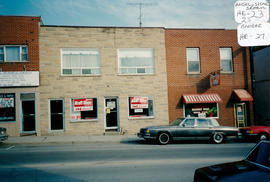- CA BWGPL GJ-HB-2017-04-05-04
- Item
- 1995
Part of George Jackson fonds
The mid-block building located on the north side at 101 John St. East was built pre-1900 in the Gothic Revival Cottage style. Originally, there was a woodshed across the back. It was the home of Mrs. Leduc or Mrs. Paul Courier, a French descendant from the old lumber mills. She wove rugs and blankets and repaired clothing. After her death the house was rented. Howard Robson and his wife lived here with part of their family, namely, Alvin, Garret and Phyllis. The building then became the home of Henry Pringle and his wife Joan. He was a retired railroad section man and owner of a garage on Holland Street. It was still the home of Joan Pringle when this photo was taken in 1995.
The 1½-storey, three-bay house has a rectangular plan, a centre hall, and a symmetrical façade.
Its medium-pitched, gable roof has a centre gable over the entrance. The building has small windows with low floor to ceiling heights. There are double-hung windows in rectangular openings with plain, wood frames and sills. The entrance porch, its windows, screen door, and the metal awnings are not original. A brick chimney at the exterior wall is also a recent reconstruction. The building has wood frame construction, vinyl siding and a parged stone foundation. Originally, the cladding was stucco. According to the 2000 inventory, the building’s basic form is camouflaged by the later additions. (1, 2, 3)
George Jackson








